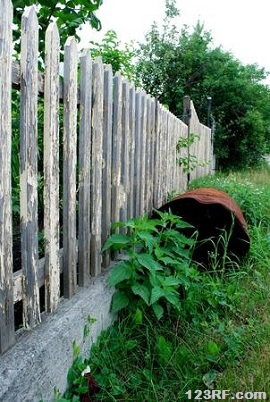Those individuals that have chosen to stay put during a time of crisis should make their house and their property look a little run down.
It must have the appearance there is nothing of value there and you would be wasting time if you stopped there to search.
Cheap Ways to Build a Fence Without Surveillance Cameras or Other Electronic Equipment.
- Use naturally growing barriers. These must not be well trimmed. Let the grass grow high, have brown spots, and lots of weeds, or as much as you can within town codes. You can plant low level vines that do not get very tall, but can easily trip anyone up trying to navigate through the lawn or back yard.
- The best fence or barrier is one that does not look like one. Start from now to plant trees and shrubs that have thorns, spread out quickly horizontally, and make a thick natural barrier. The thicker and thornier the barrier the harder it will be for unwanted trespassers to get through it.
How to Use the Lay of the Land for Natural Fences and Defenses
Before building the natural fence look at the lay of the land. Is the property level or is it angled? Are there any steep drop offs, creeks, or other land or water features that would make it difficult for someone to enter the property?
If the property is at the top of a hill, then you control all land below. On the other hand if the property is below the crest of a hill or ridge there may be problems with other people above being able to observe what is going on in your property.
You can mitigate this situation by planting a thick stand of Bamboo all the way around the property perimeter just inside the primary defensive wall. Other Bamboo stands should be planted in the back yard of the property to hide from view what is going on in the back yard and other staging areas. This Bamboo stand should be thick and dense enough to keep animals and people out.
How to use Thorny Bushes to Cover Your Property Perimeter
Spiny shrubs and trees, also often called Hedgerows, have been used for centuries to create defensive barriers, pen up live stock, or used to build up and strengthen existing boundary fences. The only down fall for using plants is that it may take some time for the plants to reach maturity.
It is possible to build a natural thorn fence around your property line. The bushes need to grow thickly and reach a height of 6 to 7 feet. When building the barriers it is a good idea to use several types of plants, as well as ones that are immune to herbicides.

Access Control Through the Natural Thorny Barriers
 Even though you may want to keep others out, being able to move freely across your own property lines is very important. You will need to decide where access points will be, as well as which ones to seal off completely.
Even though you may want to keep others out, being able to move freely across your own property lines is very important. You will need to decide where access points will be, as well as which ones to seal off completely.
- If there are any steep drop offs along the property line build a natural barrier fence at the top of the ravine that has plenty of sharp thorns. Loosen the soil to make it harder to climb up the bank and plant Poison Ivy or Poison Oak between the bottom of the ravine and the natural thorny defenses.
- For Pedestrian Traffic – keep a heavy locked outer gate. The pathway behind the gate should zig zag instead of in a straight path into the compound. A natural barrier to a second locked gate should eventually lead into the compound.
- For an Emergency Evacuation by Vehicle – There should be an emergency break out section that can only be activated from the inside perimeter. The pathway out should use the best lay of the land for concealment, vehicle speed, and safety.
If you are on a tight budget and are not going to bug out, you can still protect your property by constructing an outer perimeter wall from thorny bushes. Start now so they will be grown to a good defensive height when the time comes. The outer defenses should project that there is nothing of value here and you would be wasting time if you tried to enter.
This article has been written by Fred Tyrell for Survivopedia.
Further Reading:








































































You forgot to mention Multiflora rose! It’s a really nasty invasive bramble with razor-sharp thorns that curve backwards. You can stick a leg in, but you can’t pull it out without drawing blood! This stuff grows anywhere, and it turns into an impenetrable thicket in only a year or two. It was introduced to the US back in the ’30’s by the FFA to be a natural pasture fencing. (Bad decision–it worked too well!) You have to go out every spring and trim it back or it’ll take over your whole property. It’s even its own alarm system: If anyone tries to get through it, you’ll be alerted by their cries of pain and anguish.
I HAVE A FENCE ,TWO GERMAN SHEPARDS. FOX HOLES AND DIFFERENT WAYS TO GET TO THEM.I ALSO HAVE WEAPONS IN EVRY CORNER OF MY PROPERTY WIYH ENOUGH AMMO TO BLOW AWAY A PLATOON OF CREEPS BRING THEM ON!
Check into the old ‘hedgerow’ concept and methods. Basically, you’ll weave living trees or shrubs into a fence that will require a chain saw to get through – and it won’t be fast even with a chain saw. Let it get several feet thick, and it’ll provide home for all kinds of livestock too.
One fast growing and dense shrub is forsythia. You can cut branches and stick them down in the dirt elsewhere to spread them – or hold a few on the ground with bricks or rocks and they will put out roots where they’re held down. A dense forsythia hedge will stop vehicles, and even hold them up in the air. No thorns, but definitely not ‘penetrable’ after a few years.
Laying out cattle fencing in a weedy stretch will trip up folks pretty well too. It’s like barbed wire, only more likely legal. You can probably snarf up old rusty rolls of it if you drive around looking for it. Farms or ranches recently sold for development are good sources. Leave odd melon sized rocks or logs in the weeds to, so that those who trip in the fencing have a place to leave their teeth. And don’t forget to provide a few bushes for wasps and such to hide in. And, you can put cattle guards in any drivable entrance onto your property, so no one can sneak a vehicle in on you.
Don’t forget to put wire loosely through this, soon as a chainsaw catches it the blade will snag, at best it jams the blade, at worst it breaks the blade which kicks back and potentially takes out the user
Just as an aside and in keeping with the philosophy of projecting an image of “nothing here worth looting”, there is ALSO a lot to be said for projecting the “anything good is already gone” image. Keep some boxes or bags in the garage or equivalent of old clothes and some old appliances, toaster, tv, and some food packaging etc. Use your imagination as to what constitutes the proper camouflage. If a need develops, spread these items liberally around the property leading out the doors and away from the house as if the looters have already been to “this one”. Worst case, this tactic might at least cut down the amount of people you have to deal with as more will pass than stop to see if anything is left.
@ Nick – I think it’s a good idea, but believe there would be a balancing act required to make it look like ‘looted’ but not ‘abandoned’ or defenseless. The abandoned look would invite people to try to walk in and take shelter there, or to waltz in just to steal the copper – and then you have to defend the place anyway. If you can just make it look ‘dirt poor with nothing worth stealing or getting shot for trying to steal’, I think that’s your sweet spot. I’m not sure exactly how to achieve that look, but a few broken down yard appliances and vehicles might make it look that way. Even a pile of trash bags in the yard would help – I’d stuff them with newsprint wads so they don’t attract vermin and not use genuine trash.
It would be nice to know which bushes and trees (other than the cactus) in your list are drought and cold resistant. Anything I would plant would be too far away from any water source for me to be able to water except occasionally and I live in an area without a lot of rain. Not real hot temperatures here–only about 90 for a high on the hottest day; mostly 70s and 80s in the summer. Very cold winters–down to 20 below every once in awhile.
I suggest you take a walk in your own area Becky – along an abandoned RR track or some such thing. Whatever is growing well there and is thorny or tangles up a lot will work for security in your climate.
You might need to water more often to get them established, but once they are growing in place many of those plants are drought tolerant because they send down really deep roots so you won’t need to worry much about watering later on. And if they’re doing well in the wild near you, they’ll survive the cold too.
The cactus around here are good to 40 below, so don’t don’t ignore them just because you’re not in Death Valley. Prickly pear comes in many sizes and varieties from a few inches to several feet tall of course each has its nitch and won’t work in all places. A few placed in the right spot might be just ticket to stop someone from crawling under or over your fence in a hard to fence area.
I was reading your article “Smart Fencing to Protect Your Property on a Budget” … and I’d like to add Quince Bush to your list – why you ask … well when I bought my home (Victorian ) in a very bad neighborhood , their was a Quince Apple Bush underneath my bay window – along with knock-out Roses … my Bay is the only windows reachable from the ground -because my stone foundation is quite tall … The Quince has beautiful buds and thorns that grow up to 3 inches… and I have to cut it back 2 a summer because it grows to about 7 feet tall (it might get taller , but I never let it) … I don’t think anyone ever attempted to access those windows – even when I leave them open … made a point of showing my inner city neighbors the gashes on my arm – when I’m trimming it ….. besides it also bears fruit !!!
This is an excellent idea. May I also suggest ‘Crown of Thorn’ roses. They don’t grow particularly tall but they spread and have long thorns. Maybe a few actual plans of the placement of the various trees ,shrubs, and barriers in a subsequent article would be great.
Also consider bees. If you plant thorny fruit-plants you’ll need the bees to pollinate them, and fruit-plant flowers yield excellent honey, but most important of all is that bees are *territorial*. Once a healthy hive has settled and produced on a patch of ground, the bees think of that land as theirs. You can make your family familiar to the bees and they won’t harm you, but they’ll go after any stranger — especially any noisy one — who comes near their hive. Put the hive on a wheeled cart, make sure the cart has very big soft balloon tires so as to make a jolt-free ride, and at need you can (slowly, carefully) move the hive to where intruders are most likely to break in. I’ve seen armored cops go away quietly rather than deal with even a peaceable swarm of bees.
Leslie- I had NO CLUE that bees could recognize ‘family’ and not attack. THAT is some useful information. Thank you. One question – is this only honey bees, or does that also apply to bumble-bees and carpenter bees?
Since everyone seems interested in specific plants, I’ll add one. I know it as ‘cat briar’, and it grows in New England and south from there. Cat Briar is a woody vine, green in color, and gets some very sharp thorns. The thorns on larger vines are also large, and colored similar to Halloween candy corn except the tips are black. Deer often bite off the tips of shoots or young vines, but it will just grow thicker – and it climbs too. It has a habit of growing all over itself, kind of like steel wool, so it’s difficult to find your way out without damages if you manage to get into a mess of it.
It’s nasty stuff – or for our purposes, beautiful stuff. The vine never suffers from attacking you, but cat briar thorns have cut up every pair of boots or shoes that I’ve ever come into contact with it wearing – some cuts are over 1/16″ deep – and the thorns don’t break off when they do that. It can cut skin deep enough to ruin your outing. Also, though I’ve never seen a vine more than about 1/4″ diameter, they’re very difficult to cut with your knife if they’re that big – almost like cutting a wooden dowel.
I can’t believe nobody has mentioned bougainvillea, that stuff makes the ultimate security fencing! It’s pretty and it grows quickly, but it’s also really dense and full of nearly invisible but wickedly long and sharp thorns. Anyone trying to get over or through it without a chainsaw or a bulldozer is in for a world of hurt.
Very interesting! I have actually had this thought that this would be a good way to create security around a potential bug out shelter but I had no idea it was already an established technique. However, I had trouble coming up with a concealed entrance for myself and others whom I wanted to have access. I thought this would be an article somewhere but I didn’t see it.
After thinking about it further, I think this article was more for someone who only wanted to have to guard the entrance and not have to worry about the perimeter. I was thinking more along the lines of a shelter that was completely invisible which would be possible with the kind of brushed it grows around where I live. In my mind, this would be the best kind of security but as stated before there is the problem of creating a good concealed access. The only thing I can think of is some kind of tunnel but w completely invisible which would be possible with the kind of brushed it grows around where I live. In my mind, this would be the best kind of security but as stated before there is the problem of creating a good concealed access. The only thing I can think of is some kind of tunnel but that would create all kinds of problems for getting supplies and furnishings in and out.
Many of the things here suggest another viewpoint, that being that this particular place (your home) is “more trouble than it’s worth” and you may as well just move along to somewhere easier.